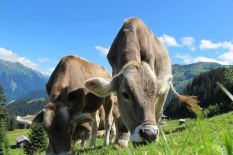New paper in Nature Microbiology explores rumen epithelial microbiome in cows

A new study including DOME members Martin Polz, Xiaoqian A. Yu, and Anna J. Mueller for the first time identifies dominant as well as active microbial populations on the rumen wall of cows. The findings could help to increase the efficiency of nutrient supply to cows making it more climate-friendly. The study has recently been published in Nature Microbiology.
The metabolic capacity of cows is remarkable. Microbes in the rumen enable them to digest plant substances other animal species are unable to utilise. However, the biology of microbes living on the rumen wall and their influence on the metabolism of feeds have remained poorly understood. Researchers at DOME, the University of Veterinary Medicine Vienna (vetmeduni) and the Austrian Competence Centre for Feed and Food Quality, Safety and Innovation (FFoQSI) in Tulln focused on previously unculturable Campylobacteraceae, a group of microbes that is particularly abundant in the rumen epithelial microbiome. They first analysed the genetic structure of Campylobacteriaceae on the rumen wall before predicting ecologically differentiated bacterial populations based on evolutionary theory. The analyses reveal that the dominant Campylobacteraceae lineage has recently evolutionarily diverged into two populations. These populations differ in gene expression and enzyme domain composition, which correspond to the ability to utilise acetate, the major carbon source for the host, at the expense of inhibition by propionate. The findings of the analyses illustrate that and how metabolic differences arising from microevolutionary processes can shape microbiological populations. The differences in metabolic properties significantly influence the availability of short-chain fatty acids to ruminants.
The study results imply that adaptations of microbial populations to feed changes can occur rapidly. This in turn can have unexpected consequences for the animals' nutritional supply. A better understanding of the composition and activity of the microbiome can help to better understand the nutrient balance of cows and make it more efficient. This could also minimise the environmental and climate impact of animal husbandry and milk production.
